Video de Youtube
"Lo que das" Video de mi canal de Youtube
Hice la letra de “Lo que das” en el colegio durante una clase aburridísima en el último año de la secundaria y habré empezado a grabarla oficialmente entre el 2010 y el 2015, lo único de lo que estoy seguro es que fue un proceso de años terminarla, al igual que todo ese primer disco. Quería trompetas a full y en esos inicios todos decían que más allá de los midis o VSTS (instrumentos virtuales emulados por la propia pc como utilizo en todo lo que haga hoy en día) había que grabar músicos reales para lograr un resultado de calidad y de última fusionar esto con los midis luego (está muy bueno hacer eso, diría que es lo correcto). Primero trató de grabarla Patricio, que en realidad su especialidad es más el mundo del audio y fabricar sus propios micrófonos que alcanzan un nivel que no envidia a ninguna marca de renombre pero los vende a un precio para el pueblo, es un amigo que me presentó Herniman, que es mi primer impulsor y técnico, después le pagamos a un tipo que no podía meter una toma bien y vino alguno que otro a ad honorem que daba el mismo resultado.
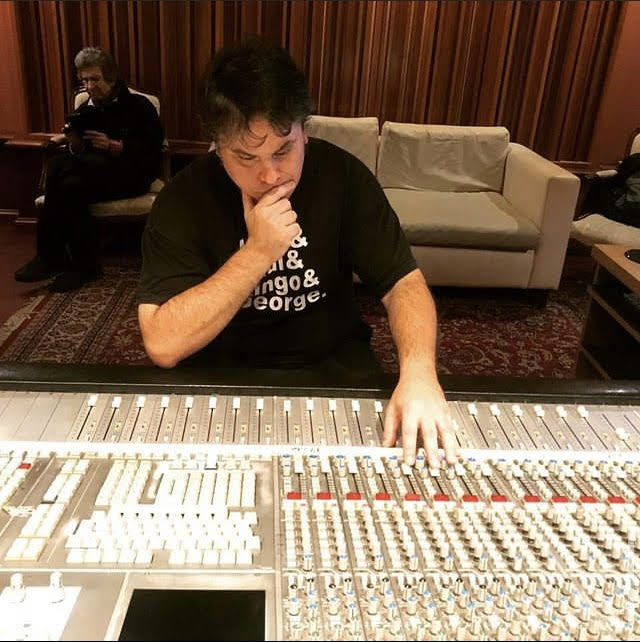
"Herniman", ingeniero de sonido de los primeros dos discos.
Instagram de Herni
Harto, escribí en Google: “los mejores trompetistas de Argentina” donde me aparecían Tallarita y Hugo Lobo. Aunque fuera un jovencito estaba totalmente consciente de que vivíamos en Argentina, osea, hasta los Rockstars de nuestro país son pobres. Tenía plena seguridad de poder llegar a ellos. Pretencioso? No lo creo. Más bien realista. Lo que sí logró sorprenderme fue la calidad humana del otro lado, ya que en ambos casos encontré un austerismo y buena onda conmovedores. Hugo llegó a decirme que no solo no quería cobrar, sino que le gustaba tanto el tema que quería producirlo. Esto nos llenó de esperanzas ya que su banda Dancing Mood pisaba muy fuerte en América y su líder nos estaba mimando. La cosa empezó bien. Nos gustaron los arreglos que Hugo metía. Los grababa en su casa y nos los mandaba. Una vez nos invitó para que escucháramos desde su Home Studio y retocáramos cosas que no nos convencían. A partir de ahí empezó un proceso que me hizo desear que nos hubiese dejado pagar inicialmente ya que siempre nos colgaba dado a sus constantes giras musicales fuera del país.
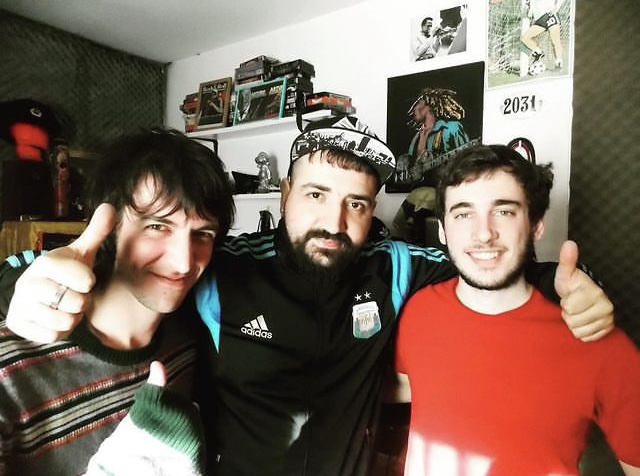
Hugo Lobo, trompetista y líder de Dancing Mood
Terminamos entonces por grabar el único arreglo faltante (son los primeros segundos de trompeta de la canción) con otro trompetista del top argentino que luego seguiría grabando con nosotros en los discos a venir: Miguel Ángel Tallarita, trompetista de los Cadillacs, del Indio Solari, de Charly y la lista sigue. El tema mezcla fue inicialmente entre todas personas que no eran productores musicales en ese momento, una era yo, otra Hernán Rago que si bien tenía idea era ingeniero de sonido, osea no era su especialidad y Gonzalo Perez Leiros que actualmente es ingeniero igual que el guitarrista de Queen. A esto se le sumaban una cantidad de opiniones externas de músicos que escuchaban y tocaban aveces aportando y aveces restando. Era igualmente una ecuación fructífera porque una vez que tenía maqueteado el tema con la estructura y la base masomenos definida ya lo hacía girar y todo lo que estos invitados aportaran lo dejábamos, lo sacábamos del todo o lo modificábamos, y me atrevo a decir que la tercer opción es la que más hacíamos! Esto sirve muchísimo como disparador o para destrabar procesos creativos, si la canción te tiene cansado o aburrido sugiero dejarla reposar y trabajar en otra o cambiarle la circunstancia, es decir, tocarla con otra gente y ver hacia donde va.
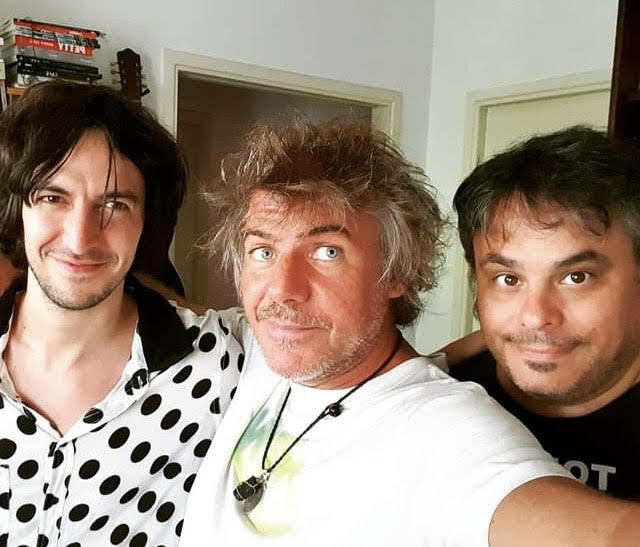
Miguel Ángel Tallarita trompetista del Indio Solari. Imagen del video del inicio.
El primer disco está hecho muchísimo con dejarle grabar a un total desconocido una toma larga y después cortar y pegar que es lo que más movió el alma. Lo recomiendo fuertemente si el tema ya no está dando lo que sea que uno está buscando. Siempre eran personas distintas, recuerdo que el primo de Hernán, Ezequiel, metió un bajo genial para el tema. Oscilábamos entre gente totalmente desconocida y primeras figuras tipo “La Mosca”, el autor de Muchachos la canción del mundial 2022, y mil hits más.
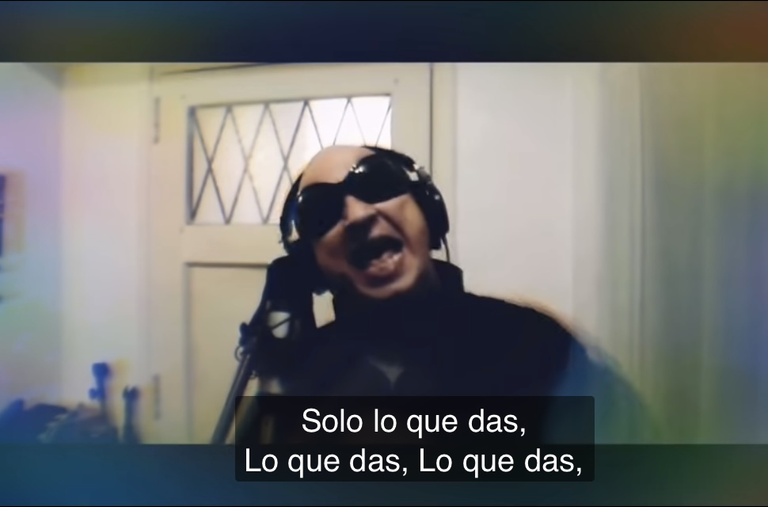
“La Mosca” grabando coros en la casa de Hernán. Imagen: captura del video del inicio.
Igualmente más que músicos lo que anhelaba y seguía buscando era un productor, alguien que se dé maña mezclando y masterizando, era chico y quería aprender ese punto para ver la peli completa. Los planos, los volúmenes y los sonidos son los que definen la cosa. Como mencioné en mi post de introduceyourself esa persona era Agustín, pero como no se encontraba disponible en ese momento diría que apareció Gonzalo “Gutty” Gutiérrez que empezaría a auspiciar de productor musical y grabación de guitarras y coros en muchos temas de ese disco, aunque yo me sintiera más en consonancia con Agus. Si bien Gutty aportó en el tema y otros logramos cerrarlos “Lo que das” no fue el caso. Es entonces que en medio de esta búsqueda, en un habitual asado de la familia de mi primera novia Magalí Saleme esta me patea por debajo de la mesa insistiendo que le pidiera ayuda a Tweety González, que se encontraba sentado justo enfrente.
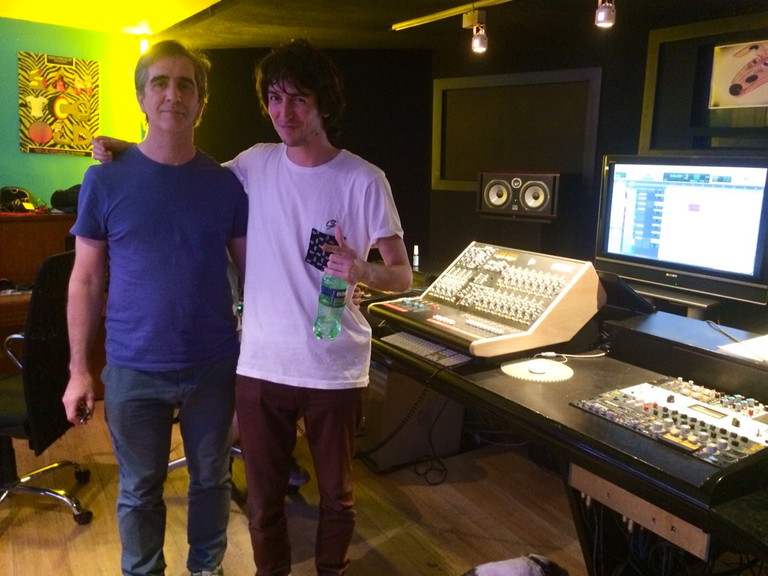
Tweety González productor de Soda Stereo
Quién es Tweety? Aparte de ser la pareja de la tía de Magalí es el 4to Soda Stereo y el productor musical de más renombre de América (productor d Fito, Spinetta, los Kuriaki blablabla). Sí, a ese tipo yo veía normalmente todos los fines de semana. Le pregunté si tenía alguien de confianza para mezclar mi disco a lo que el contestó: “ Y no podría ser yo?”. Aparentemente ya me tenía algo escuchado y me ofrecía mezclar el primero casi de onda. Luego habría que poner la tarasca. Tan joven como feliz me presenté muy entusiasmado entonces donde Tweety producía, el Pie Recording Studios, estudio de Alejandro Lerner que por cierto no sobreviviría a la pandemia mundial. Ahí estaba Tweety con su asistente El Nono di Peco y su perrito Lele. Un tipo grande que fumaba porro y comía más chocolate que cualquier niño del lugar. Cuando no hacía eso trabajaba y me preguntaba si me gustaba. Creo que “Lo que das”, el primero, fue el que mejor mezcló. Luego se fue desentendiendo y poniéndole cada vez menos pilas. Me laburó como en 4, 5 en total. Pese a ser Tweety pasé a no estar convencido y justo estaba ya entrando mucho en contacto con Agustín Dellacroce ( a quien mencionó en el primer post que escribí de #introduceyourself) “Lo que das”terminaría pasando por sus manos y Julián Aznar para masterizarlo. Ambos quedarían establecidos como mi fórmula ganadora para todo lo que venía.
Resumiendo: De mi cabeza pasó al living de Hernán con el y Gonza, a la casa de Hugo Lobo, a estudios diversos con Gutty, a lo del mismísimo Tweety y finalmente a lo de Agustín y al mastering de Juli Aznar… Una demencia! El proceso sobre todo de este primer disco es una locura total, un proceso de descubrimiento en lo técnico que luego de encontrado el equipo todo pasaría a todo a otro nivel de eficiencia y velocidad. Fue un proceso de sacarse todas las dudas tanto de tipo técnico como a nivel humano.
Gracias por haber llegado hasta aquí! Seguimos en contacto para todo lo que se viene. Los saluda Yanni de Divino Beats.
ENGLISH
Video of my Youtube Channel
I wrote the lyrics for "Lo que das" during a very boring high school class in the last year, and I officially started recording it between 2010 and 2015. The only thing I'm sure of is that it took years to finish, just like the entire first album. I wanted full-on trumpets, and initially, everyone said that, beyond using midis or VSTS (virtual instruments emulated by the computer, as I use in everything today), it was necessary to record real musicians for a quality result, eventually merging this with midis (which is great to do, I would say it's the right way). First, Patricio tried to record it, whose specialty is more in the audio world and making his own microphones. He introduced me to Herniman, my first supporter and technician. After that, we paid a guy who couldn't get a good take, and some others volunteered ad honorem, yielding similar results.

"Herniman" Sound engineer for the first two albums. Instagram Herniman's photo
Frustrated, I googled "the best trumpeters in Argentina," and Tallarita and Hugo Lobo came up. Despite being young, I was fully aware that we lived in Argentina, where even our rockstars are poor. I was confident I could reach them. Pretentious? I don't think so. Realistic, rather. What did surprise me was the quality of humanity on the other side, as in both cases, I found touching modesty and good vibes. Hugo even told me he not only didn't want to charge but liked the song so much that he wanted to produce it. This filled us with hope since his band, Dancing Mood, had a strong presence in America, and their leader was showing us affection. Things started well. We liked the arrangements Hugo made. He recorded them at home and sent them to us. Once, he invited us to his Home Studio to listen and tweak things we weren't convinced about. From there, a process began that made me wish he had let us pay initially, as he often left us hanging due to his constant musical tours abroad.

Hugo Lobo, trumpeter and leader of Dancing Mood
We ended up recording the only missing arrangement (the first seconds of trumpet in the song) with another top Argentine trumpeter who would later record with us on upcoming albums: Miguel Ángel Tallarita, trumpeter for Los Cadillacs, Indio Solari, Charly, and the list goes on. The initial mix involved people who weren't music producers at that time, including myself, Hernán Rago (who, despite having an idea, was a sound engineer, not his specialty), and Gonzalo Perez Leiros, who is currently an engineer like the guitarist for Queen. This was combined with various external opinions from musicians who sometimes contributed and sometimes detracted. It was a fruitful equation because once I had the song roughly mapped out with the structure and base more or less defined, I would let it evolve. Everything these guests contributed was either kept, removed altogether, or modified. I dare say the third option was the one we used the most! This method works wonders as a trigger or to unlock creative processes. If the song tires you or bores you, I suggest letting it rest and working on another or changing the circumstance, such as playing it with other people to see where it goes. The first album was created a lot by letting a total stranger record a long take and then cut and paste, which is what moved the soul the most. I highly recommend it if the song is not delivering what you're looking for. It was always different people; I remember Hernán's cousin, Ezequiel, added a great bassline to the song. We oscillated between completely unknown people and top figures like "La Mosca," the author of the song for the 2022 World Cup, and many other hits.

"La Mosca" recording backing vocals at Hernán's house
More than musicians, what I longed for and continued to seek was a producer—someone skilled in mixing and mastering. I was young and wanted to learn that aspect to see the whole picture. As I mentioned in my introduceyourself post, that person was Agustín, but as he wasn't available at that time, Gonzalo "Gutty" Gutiérrez appeared and started sponsoring as a musical producer and recording guitars and vocals on many tracks of that album, even though I felt more in tune with Agus. While Gutty contributed to other tracks, we couldn't close "Lo que das" with him. It was during this search, in a usual barbecue with the family of my first girlfriend Magalí Saleme, that she kicked me under the table, insisting that I ask for help from Tweety González, who happened to be sitting right across from us.

Tweety González, producer of Soda Stereo
Who is Tweety? Besides being Magalí's aunt's partner, he is the fourth member of Soda Stereo and the most renowned music producer in America (producer for Fito, Spinetta, Los Kuriaki, etc.). Yes, I used to see that guy almost every weekend. I asked him if he had someone reliable to mix my album, to which he replied, "Why not me?" Apparently, he had already heard something of mine and offered to mix the first one almost for free. Then we'd have to put up the money. Young and happy, I showed up very excited where Tweety was producing—the Pie Recording Studios, Alejandro Lerner's studio, which, by the way, did not survive the global pandemic. There was Tweety with his assistant El Nono di Peco and his dog Lele. A big guy who smoked weed and ate more chocolate than any kid around. When he wasn't doing that, he worked and asked me if I liked it. I think "Lo que das," the first one, was the one he mixed the best. Later, he started getting less involved and putting in less effort. He worked on like 4 or 5 in total. Despite him being Tweety, I became unconvinced, and just as I was getting in touch with Agustín Dellacroce (whom I mentioned in the first post I wrote on #introduceyourself), "Lo que das" would end up in their hands for mixing and Julián Aznar for mastering. Both would be established as my winning formula for everything that followed.
In summary: From my mind, it went to Hernán's living room with him and Gonza, to Hugo Lobo's house, to various studios with Gutty, to Tweety's place, and finally to Agustín's and Juli Aznar's mastering... Madness! The process, especially for this first album, is a total madness, a discovery process both technically and humanly. After finding the right team, everything would escalate to another level of efficiency and speed. It was a process of clearing all doubts, both technically and on a human level.
Congratulations @divinobeats! You have completed the following achievement on the Hive blockchain And have been rewarded with New badge(s)
Your next target is to reach 600 upvotes.
You can view your badges on your board and compare yourself to others in the Ranking
If you no longer want to receive notifications, reply to this comment with the word
STOPCheck out our last posts:
Thank you very much!!!!!
Keep up the fantastic work @divinobeats! Your dedication and hard work will pay off when you reach your target.
🤜🤜🤜💪🏾💪🏾💪🏾💪🏾
¡Qué interesante historia detrás de "Lo que das"! El hecho de que hayas comenzado a escribir la letra durante una clase aburrida en el último año de secundaria agrega un toque especial. El proceso de grabación a lo largo de varios años muestra tu dedicación y compromiso con tu arte. La búsqueda de trompetas reales y la combinación de músicos reales con midis para lograr calidad demuestra tu enfoque meticuloso. Es genial ver cómo has trabajado con amigos y técnicos para dar vida a tu visión musical. ¡Espero escuchar más sobre tu viaje creativo y disfrutar de "Lo que das" pronto!
Cómo estás ??? Muchas gracias!!!! Está subida hace años!! Ahí en el link la puse!